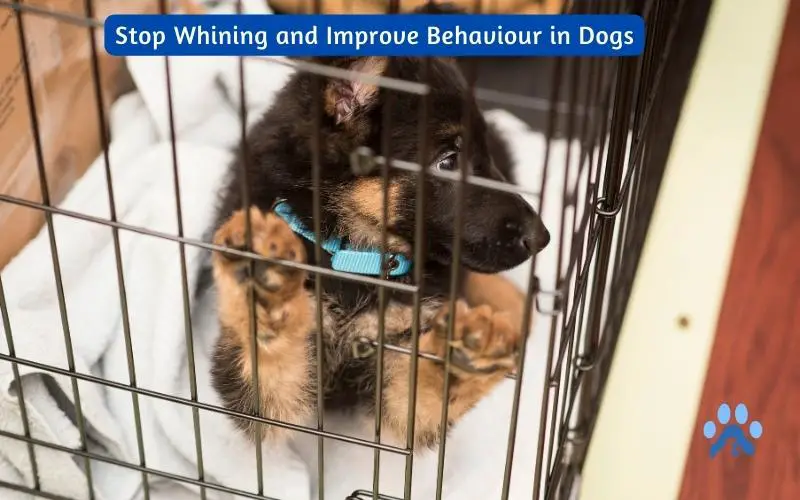When training our dogs, we all want to do what’s best for them. Using tools like shock collars to control a dog’s behavior can be controversial, but in some instances, a shock collar can be helpful.
Shock collars have long been used to help curb unwanted behaviors like barking, whining, and even aggression. However, in recent years, shock collars have been gaining popularity in addressing the problem of whining in the crate.
This blog post will explore using a shock collar for whining in the crate. We’ll discuss the pros and cons of using a shock collar and offer tips on when and how to use the tool if you decide it’s right for your dog.
Understanding the power of a shock collar and recognizing when it’s unnecessary are essential for ensuring your dog’s training is positive and effective.
Here’s what you need to know,
How does the Shock Collar Works?
A shock collar can be an effective tool for correcting whining behaviors in crate settings. The collar delivers a mild electrical stimulus to the dog when the whining occurs.
This mild shock deters the dog from engaging in undesirable behavior. As an added measure, the shock collar can produce a sound or vibration to accompany the shock, reinforcing the association between the noise and the shock.
Over time, the goal is to reduce the number of shocks until the dog no longer engages in the undesirable behavior.
It is important to note that the shock should be used with positive reinforcement, such as verbal praise and treats, to ensure the dog is learning the desired behavior.
Why Do Dogs Whine in Crates?
Dogs are social animals naturally inclined to seek out interaction with their owners. When a dog is placed in a crate, it may whine to express feelings of isolation, anxiety, and stress.
In addition, dogs may whine due to physical discomforts, such as hunger, thirst, or the need to go to the bathroom. It is essential to pay attention to the reasons for a dog’s whining to ensure its needs are being met.
If a dog is whining due to loneliness, providing them with toys, treats, and other forms of enrichment can help reduce their anxiety and stress.
If the whining is due to physical discomfort, providing the dog with food and water or taking them outside to relieve themselves can help stop the whining.
Understanding why dogs whine in their crate can help owners provide the best care to their canine companions.
Training With the Shock Collar
It is essential to use this training method in a thoughtful and humane way, as shock collars can address negative behaviors without causing any physical discomfort to the dog.
Proper shock collar training involves setting consistent rules and rewarding positive behavior to reinforce desired behaviors.
When used correctly, shock collar training can help to break the habit of whining in crates, as it can help to redirect the dog’s focus to other activities and provide an incentive to keep the dog quiet.
Step-By-Step Instructions for Teaching Your Dog to Stop Whining
- Place your dog in the crate and give a verbal cue such as “quiet” or “settle”;
- Activate the shock collar, giving your dog a mild correction when they whine;
- Immediately offer your dog a treat when they stop whining;
- Repeat this process until your dog associates the verbal cue with the shock collar and stops whining without any further correction;
- Once your dog has learned to stay quiet in the crate, gradually decrease the intensity of the shock collar and reward good behavior until your pet no longer needs the device.
Pros and Cons of Using a Shock Collar
Using shock collars to stop whining in crates is a controversial issue among pet owners.
On the one hand, shock collars can effectively correct undesirable behavior in dogs, including whining in crates. They can deliver a mild shock when a dog begins to whine, which can quickly stop the behavior.
On the other hand, shock collars can be seen as cruel and cause negative psychological and physical effects on the dog, such as fear and anxiety.
It is essential to understand that shock collars are not a substitute for proper training and should be used cautiously.
In addition, pet owners should always use the lowest setting possible when using a shock collar, as using a higher setting could cause long-term damage to the dog.
Alternative Ways to Teach Your Dog to Stop Whining in Crate
First, provide your dog with plenty of exercises, playtime, and mental stimulation before placing them in the crate.
Provide a comfortable bed and a few toys or chews to keep your dog occupied while in the crate.
When your dog begins to whine or bark, calmly say “quiet” or “enough” and wait for them to stop. If they stop, give them a treat and praise.
If your dog does not stop whining or barking after a few minutes, you can get up and walk away from the crate, calmly saying “quiet” or “enough” as you go.
Till your dog is quiet, avoid making eye contact with them or speaking to them.
Once your dog is quiet, return to the crate and give them a treat and praise.
It’s essential to be consistent in your approach and to give your dog the time to learn what is expected of them.
Remember that this is a process that takes time and patience, but with consistency and patience, you can help your dog learn how to be quiet in the crate.
Conclusion
Shock collars can be an effective way to limit and reduce whining in a crate. However, since the collar is not a long-term fix, it is crucial to remember that you should only use it momentarily.
Also, ensure the shocks are not too intense and train your dog on proper crate behaviors.
Additionally, reward your dog when they do not whine and create a positive atmosphere in the crate. Shock collars may help reduce or even eliminate crate whining with proper training.
Frequently Asked Questions
Does a shock collar work for whining?
While shock collars should not be used as a first line of defense, in some cases, they can be valuable tools for managing persistent whining.
Sensibly using shock collars with constant teaching and reinforcement is essential. Training should take place in a quiet and unhurried atmosphere to protect the safety of the dog.
When used appropriately, shock collars can help to reduce whining by providing a gentle reminder or distraction from unwanted behavior.
Can you use a shock collar for crate training?
Shock collars are not recommended for crate training, as any punishment can cause fear and anxiety in dogs.
You can give your dog a secure, cozy, and safe environment with crate training. Treats and other forms of encouragement should help the dog form positive associations with the crate. The goal of crate training should be to develop trust between you and your pet.
Additionally, aversive techniques such as using shock collars can have long-term detrimental effects on the behavior and well-being of your dog, so they should be avoided.
Can I use a bark collar in a crate?
Using a bark collar in a crate is a controversial topic. On the one hand, some argue that the collar will help quickly break the barking habit, while others believe it can be cruel and cause anxiety.
It’s crucial to remember that the bark collar should only be used as a last option if other measures have failed.
Experts recommend that the bark collar be used only when the dog is supervised and not left in the crate for long periods, as it can be dangerous.
Additionally, the collar should be removed before the dog is taken out of the crate, as the collar could interfere with the dog’s ability to learn how to do and behave appropriately.
Why does my dog keep whining in his crate?
Dogs may whine in their crate for various reasons, but the most common is feeling anxious or uncomfortable.
For example, if the crate is too small or noisy, a dog may feel that it cannot escape the situation and may become distressed. It’s crucial to evaluate the environment the dog is kept in and make any required modifications.
The dog might also be attempting to express a need, like hunger or thirst. If a dog has not been adequately trained to stay in the crate, it may try to express its dissatisfaction with the situation by whining.
Can you use a shock collar to crate-train a puppy?
Crate-training puppies with a shock collar is a controversial practice that is not widely recommended.
Although some may think this method could be effective, it is not a humane approach to teaching a puppy how to adjust to its crate.
Positive reinforcement techniques such as treats, rewards, and verbal cues with your puppy are far more effective when crate-training.
This creates a positive association, and the puppy is likelier to take to the crate willingly and happily.



